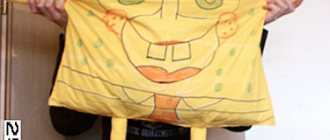Orthodox Easter in Russia remains the main holiday for all believers. And if your family is going through a difficult period or, on the contrary, everything is fine right now, the Bright Resurrection of Christ is the day that will help you believe in the best and unite adults and children.
Tell your child the history of the main Orthodox holiday, play special Easter games, create unusual crafts and give children gifts suitable for the occasion. Get even closer to each other on the bright day of Easter!
Take care of the health and safety of your child, even when you are not around! Find out how he is feeling in kindergarten or primary school, quickly contact if necessary and listen to what is happening around with the help of the #1 app for caring parents “Where are my children”.
History, traditions and symbolism of Easter for children: how and what to tell
When telling the story of Easter, consider the age of the child. You can tell a preschooler only basic information, without focusing on details that are difficult for children to perceive. For example, a story about the Easter story for a child could be like this:
“A long time ago, the son of God, Jesus Christ, lived on our earth. He never offended anyone, never did anything bad, and always spoke only the truth. Jesus also taught other people to do good deeds and not to deceive loved ones. ⠀ In those days, an evil king ruled the world. He did not want people to learn from Jesus - because this way they could understand that their king was bad and overthrow him. That evil king ordered Jesus to be crucified on the cross - then this was how dangerous criminals were punished. And on the third day after the execution, the son of God resurrected - that is, he became alive again. So Christ showed people that the bright human soul is immortal.”
Schoolchildren can be told a more complete story of Easter using the children's Bible as a basis. What facts can be covered in the story:
- betrayal of Judas - how the disciple betrayed Christ for 30 coins;
- crucifixion - how the cross became a symbol of salvation for all Christians after the crucifixion of Jesus;
- Resurrection is about the resurrected soul of Jesus Christ, and that the seventh day of the week is called Sunday in honor of the resurrection of Christ.
Traditions and symbols
In Orthodoxy, there are many customs, traditions and symbols associated with Easter. You can tell your child about the main Easter traditions and symbols that are still common today:
- on a holiday, it is customary to say at a meeting “Christ is risen” and hear in response “Truly he is risen!”;
- On Easter, special Easter cakes are baked - the custom is associated with the exceptional place of bread on the Orthodox table;
- Painted eggs are certainly placed on the Easter table, which symbolize the birth of a new life - this is how Christ was reborn after the crucifixion.
In Rus', Easter itself and the entire next week were solemnly celebrated. Children danced in circles, played folk games, and decorated houses. Unfortunately, the tradition of Easter fun has practically not survived to this day, but it can easily be implemented in your own family.
A selection of Easter matinee scenarios for older preschoolers
Since the goals and objectives of organizing leisure activities in senior and preparatory groups are identical, in methodological practice, matinee scenarios for these age categories are universal. When choosing a composition, the teacher focuses on the general level of development of children, that is, assesses their potential for realizing a creative idea.
Developed by Markova R.P. “Easter holiday in kindergarten in the senior preparatory group” uses as a dramatization the plot of the fairy tale about Kolobok, who rolls towards the Temple and asks Father to sprinkle him with holy water. The priest not only gives him a blessing, but also treats Grandma and Grandpa with colored eggs.
“The script for the Easter holiday “Bright Easter” by Tverdokhlebova O.L., is designed for children in the preparatory group. The author invites the children to take part in staging a scene from a biblical story when people discovered the resurrection of Christ. However, despite the originality of the composition, this scenario requires a long preparatory stage, since appropriate costumes are needed (nun, princess, maid), as well as careful study of the roles, that is, individual work with the child artists.
In the script of the matinee by Vasilyeva E.B. “Easter” the role of the host is played by an adult, and the event itself combines the themes of Easter and the meeting of spring.
“Easter scenario in kindergarten in the senior group” is based on thematic games with eyeliner poems. In addition to the presenter, the production involves the characters Sun and Spring, whose costumes add brightness to the matinee.
Petlyakova S.D. in the script for the “Easter holiday for children of the senior and preparatory groups,” the functions of the presenters are distributed between two buffoon characters. This approach not only adds festiveness to the event through images, but also justifies its playful nature.
In the “Matinee dedicated to Easter”, the essence of the holiday is revealed in poetic form at the beginning of the event, and then in the dramatization “Who Built This House” the theological approach to the question of the creation of the world is revealed.
Video: fragment of a matinee dedicated to Easter for older preschoolers
Gifts for children for Easter
Giving gifts for Easter used to be considered almost obligatory. On the day of the Holy Resurrection of Christ, people usually went to visit, and it was not customary to come to someone else’s house empty-handed.
Nowadays the tradition of giving gifts for Easter is almost not observed. But you can give your children something they have long dreamed of or simply give them a nice little thing - this will make the bright holiday even more joyful for the child.
Easter gift options for children:
- basket of sweets;
- soft toy;
- book;
- dishes with themed spring decorations;
- interactive toys;
- children's Bible;
- unusual sweets: gingerbread cookies with Easter designs, chocolate lambs, bunny-shaped candies.
You can encourage your child to think about making gifts for loved ones himself. A child can give parents and other relatives souvenirs made with their own hands: postcards, a basket of Easter eggs, a beautiful cardboard box for storing small items, originally decorated eggs.
On the eve of Easter
Orthodox Christians prepare for this day for quite a long time - as much as 49 days. This is how long Lent lasts - the longest and most strict fast. Its goal is not only to cleanse the body by not consuming meat, eggs and other animal products, but also to cleanse one’s soul, because during fasting one cannot be angry, swear, or take offense. Cleansing the soul is perhaps even more important than food restrictions.
The most important period of these 49 days is the last week, during which each day is important in its own way, since each day has its own mission:
- Great Monday. The hardest day of fasting. Food is taken only once in the evening. On this day it is customary to start cleaning the house before Easter;
- Great Tuesday. On this day the sermons of Jesus are remembered. At home, on Tuesday it is customary to do laundry, continuing preparations for the big day;
- Great Wednesday . This is the day of confession, and also believers remember Judas. Houses begin to prepare food for Easter and continue cleaning;
- Maundy Thursday or Maundy Thursday . On this day, cleaning the house ends, and all household members wash themselves. All this should be done before sunrise. Such a font washes away all sins. Also on Thursday, the Last Supper is remembered;
- Good Friday is the day of Christ's crucifixion. Therefore, on this day, believers do not eat food at all (with the exception of children, the elderly and sick people). Christians mourn and remember the torment of Jesus. They do nothing around the house on Friday;
- Holy Saturday. Preparations for the Great Resurrection are being completed - dishes are being prepared, Easter cakes are being baked, eggs are being colored. All these preparations must be completed before the church service. Believers go to services all night.
- Great Resurrection, Easter. On this day, Christians break their fast, that is, they begin to consume products of animal origin, and they begin to do this with eggs - one of the symbols of resurrection, new life. On Sunday everyone walks and has fun.
Holiday scenario
You can spend Easter with your children according to a pre-prepared scenario, taking into account all the stages: preparation, congratulations, and the celebration itself.
Sample Easter scenario with children:
Preparation
On the eve of the holiday, paint eggs together, bake a cake and decorate the house. Candles, homemade paper garlands, thematic drawings and appliques are suitable as decor. While preparing together, unobtrusively tell your children about the history of Easter - by actively participating in creating the Easter atmosphere, the child will quickly learn new information. If the children are small, help them prepare gifts for the rest of the family.
Congratulations
Immediately after waking up, congratulate the children on the Bright Resurrection of Christ. If possible, go to church together and bless the Easter cake and eggs. If you can’t leave the house, give your child a gift and give him time to enjoy the surprise. Remind your children not to forget to congratulate all loved ones and give them gifts.
Celebration
Prepare a festive table with your child and invite the rest of the family to join. Teach children to “clink glasses” with paints and show how quickly a hard-boiled egg spins. After Easter lunch, you can move on to the entertainment part: games and competitions.
Easter is the brightest day for believers, and even if your family is not very religious, you can tell your child about Christian customs and symbols. Perhaps you yourself will learn something new or remember a well-forgotten old one, as if returning to your own childhood, where your parents taught you ancient Easter traditions!
Stage decoration
The setting for the matinee can be standard: a table, Easter treats or their imitation (painted eggs, Easter cake). The words “Easter”, “Christ is Risen!” can be attached to the back of the stage! Truly risen!” On the walls of the hall you can arrange an exhibition of thematic drawings of the children. If the script considers Easter in the context of the onset of spring, then you can build a decoration that imitates the spring view from the window.
When developing the script for the matinee, it is important to remember that this is a festive event, which means that children should be dressed up, in costumes that reflect the essence of the role they are playing.
To create a festive atmosphere, participants in the matinee must wear costumes
Introducing preschool children to one of the most important Christian holidays involves studying the history and traditions of Easter not only in the context of direct educational activities, but also in the process of preparing a thematic matinee. The festive event, in addition to entertaining the children, also allows you to summarize all the material studied. And this, in turn, is the key task of studying this topic with children of older groups.
Board games
Board games are the simplest option and do not require special equipment. In addition, children will be able to play in kindergarten or at home without going outside.
deflating an egg
You need to prepare an egg for the game. To do this, punch a small hole in a raw egg and pour out the contents. We wash the shell from the inside. It will be great if the egg is painted or painted, as it should be for a real Easter attribute!
Place the empty egg in the center of the table. All guests - children and adults - sit around the table as close to each other as possible, dividing into two teams. On the count of three or four, one of the teams begins to blow on the egg. Each player tries to blow it to the opposite end of the table so that it eventually falls to the floor. The second team must resist and blow the egg towards their opponents with all their might.
Who will manage to blow the egg off the table?
Egg collectors
While you are preparing for the arrival of guests, you can entertain the kids by offering them this game. We cut out 12 eggs from white thick cardboard and draw bright spring flowers from one to twelve on them. To enhance the educational effect of the game, you can depict different flowers and sign their names.
The eggs are laid out on the table, flowers side down. Each player takes turns taking one egg. The one who has more flowers painted on the egg keeps the “trophy” for himself. The opponent places the egg with fewer flowers back on the table and shuffles the card eggs.
Who will collect the most flower eggs?
"Find the Egg"
This game can be organized both in an apartment and at a summer cottage or in the forest. It will be interesting to conduct it both with one child and with a group of children.
You will need colored eggs and small surprise prizes: candy, stickers, small toys, etc. An adult hides Easter eggs and prizes indoors or at a summer cottage in advance, and a child or group of children will have to find them. If there are a lot of children, you can divide them into two teams. Children take the surprises they find for themselves.
The simplest version of the game is to simply hide the gifts in different places. Unusual options for hiding places: stick it with tape under the seat of a chair or put it in the paws of a soft toy.
More difficult game options:
- Before putting the prize in the cache, tie a thick thread to it, then walk around the apartment with this thread, entangling it with various objects on your way. The child finds the end of the thread and, winding it into a ball, reaches the prize. Use threads of different colors.
- You can borrow an idea from the game “Cossack Robbers” by marking the path to the surprise with arrows.
- The most interesting option is when a child finds a surprise from a series of notes. Moreover, the first note indicates where the second is hidden, the second - where the third, etc. From the last note, the child learns where the cache with the prize is.
Advice
If the child is small and does not yet know how to read, drawings or photographs of hiding places can be used in the notes. You can draw a map of the room, marking with crosses the places with notes. Children who already know how to read can read and complete the tasks written in the notes. For example, solve some logical puzzle before finding out the location of the next cache, or solve a puzzle.
Chasing two birds with one stone
For this game we will need 3 wooden eggs (colored eggs).
We put two dyes next to each other. You need to hit the third one so that they roll in different directions. Whoever succeeds in this will receive some kind of prize.
Memory game "Easter eggs"
The game is designed to train visual memory. The set contains 16 cards with Easter eggs of different colors - two each with the same design. Two people play. Before starting the game, you need to lay out the cards face down on the table, and then turn them over two at a time. If they match, the player takes them and gets another turn. If not, the turn goes to another player. The task is to collect as many cards as possible.
Print out the form with Easter eggs from the link in duplicate. Before cutting out the eggs, print a “shirt” on the back of each sheet. Cut out Easter eggs (8 pairs). Easter memory game is ready!
Easter maze
Draw a pencil line from the entrance and find the exit.
Coloring pages
Find Easter eggs and color them.
Easter lotto for kids
Print 6 handout sheets and 15 picture cards from the link. Give each child participating in the game one sheet of paper. The adult leader takes out one picture card at random from the pile and shows it to the participants. The one who has such a picture on the handout sheet covers it with a “chip”. The following can be used as chips: nuts, M and M's candies, seeds, buttons, etc. The winner is the one who is the first to cover three pictures on his sheet horizontally, vertically or diagonally.








